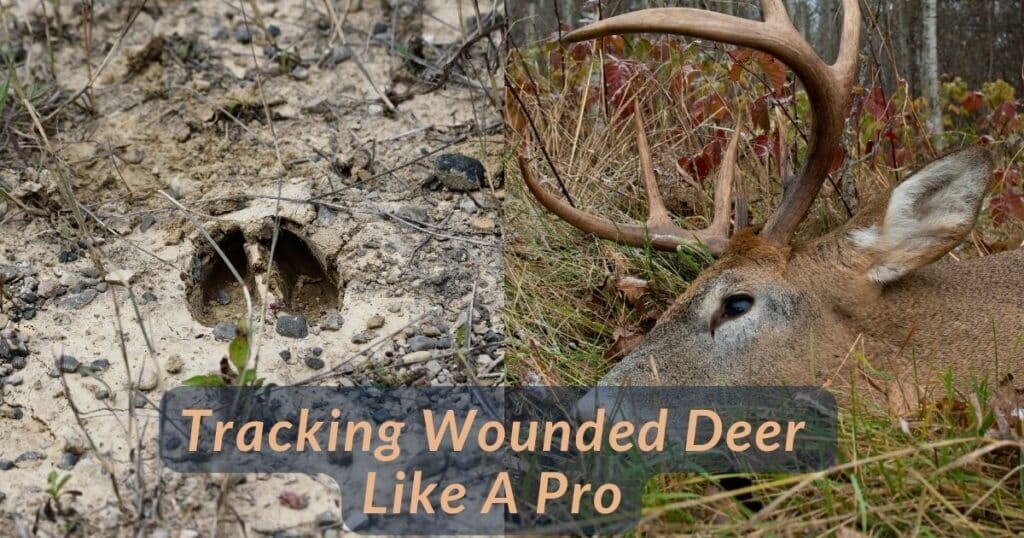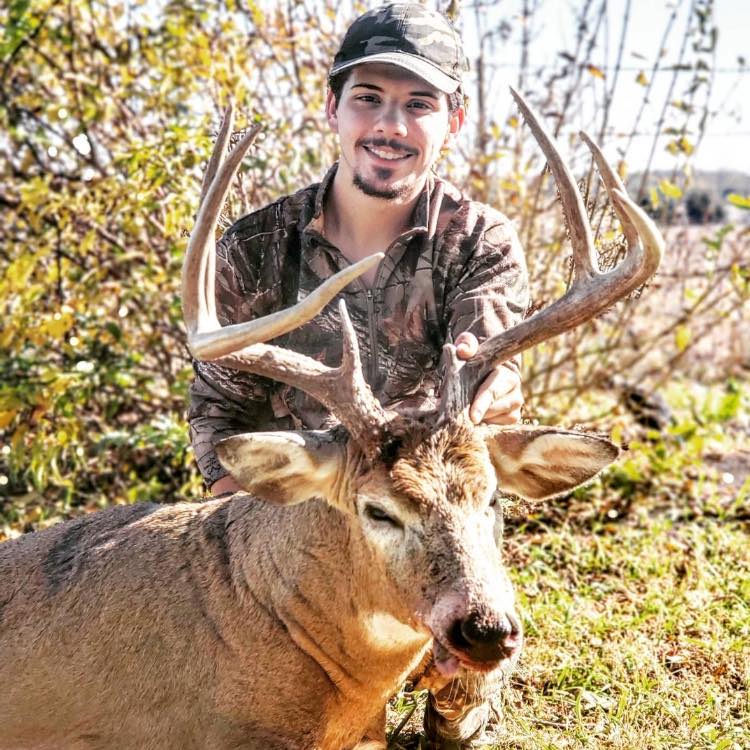The thrill of the hunt often culminates in the shot. In an ideal world, every shot would result in a clean, ethical kill, with the animal dropping in sight. However, reality begs to differ. Even the most skilled deer hunters can face situations where the shot doesn’t result in an immediate kill, leading to the arduous and ethically crucial task of tracking a wounded deer. A wounded deer can pose a significant challenge, especially when the blood trail fades or disappears altogether. This comprehensive guide, drawing on insights and techniques from seasoned hunters, aims to equip you with the knowledge to track a wounded deer like a pro.
How To Track A Wounded Deer: Tracking a Deer Like a Pro

Preparation for Tracking
Before setting off on the tracking process, it’s essential to prepare yourself mentally and physically. Tracking a wounded deer can be a time-consuming and mentally demanding task, requiring patience, focus, and attention to detail. Understand that tracking a wounded deer may involve following a blood trail over long distances, through thick cover, and in various weather conditions. Being mentally prepared and having the right mindset will help you stay focused and determined throughout the tracking process.
Proper preparation can significantly increase the chances of successfully recovering a wounded deer. Here’s what you need to have and know before embarking on the search.
Essential Gear
- A flashlight or headlamp for tracking during low-light conditions.
- Use marking tape to mark blood trails and landmarks.
- A compass or GPS device can be invaluable in unfamiliar territories.
Safety Considerations
Always inform someone of your tracking plans and estimated location. Additionally, a first-aid kit is a must-have for unforeseen injuries.
Legal and Ethical Considerations
Ensure you’re familiar with local hunting laws regarding tracking and dispatching wounded game. Moreover, adopting a humane approach throughout the process is not only ethical but a fundamental aspect of responsible hunting.
You can check the crossbow laws if you plan to use one for hunting. It’s important to follow all regulations and guidelines to ensure a safe and legal hunting experience. Understanding and respecting these laws contribute to the well-being of both the hunter and the wildlife population. Always prioritize safety, ethical practices, and compliance with hunting regulations to enjoy the sport responsibly.
Understanding Shot Placement, After Shot Reaction and Type Of Blood
Heart and Lung Shots
Aiming for the “hilar area” or Kill Zone (which includes the heart and lungs) is fundamental for an ethical shot. A well-placed heart shot here often results in bright, frothy, or bubbly types of blood due to heart or lung damage.
The deer may leap in the air, kick its hind legs (a “mule kick”), or run off briskly. These signs indicate a potentially lethal double lung shot, with the animal unlikely to travel far. Most of the time, the deer can be found within 80 to 100 yards.
Knowing the best places to shoot a deer can help you reduce the distance you need to track it.
Gut and Liver Shots
A deer that hunches up or kicks its hind legs without the “mule kick” might indicate a liver or gut shot, characterized by darker blood and a distinct, unpleasant smell. Such hits necessitate patience, as pushing the animal too soon can result in far more difficult tracking conditions.
In addition to body language, the direction of travel is another key factor to consider. If the deer runs in the opposite direction of the shot, it may indicate a gut shot, as the deer instinctively tries to put distance between itself and the source of pain. If the deer runs in the same direction as the shot, it suggests a lung shot, as the deer’s immediate reaction is to flee from the impact.
Analyzing the deer’s immediate reaction is the first step in tracking a wounded deer. It provides essential information about the type of shot and the severity of the wound, setting the stage for the tracking process.
Post-Shot Actions: Mark, Listen, and Wait
Mark Your Spot
Immediately after the shot, mark the last known position of the deer. Use bright toilet papers or marking flags or natural landmarks to pinpoint this location. Observing the deer’s reaction and listening to the direction of its departure is crucial in determining how and where to start tracking.
To enhance visibility, it is wise to use lighted arrow nocks and brightly colored fletching. Crafting your arrows with specific color patterns aids in identifying blood trails. If the deer bolts, mark its exact spot to streamline your tracking efforts.
What To Do after Shooting a Deer
A common mistake is to rush after the deer immediately after shooting a deer. Lots of new hunter often ask me how long to wait after shooting a deer, the rule of thumb is at least 30 minutes to several hours depending on the shot placement. A waiting period allows the deer to bed down, making it easier to track. Assessing the impact of the shot placement also helps anticipate the deer’s likely behavior and eventual stopping point.
For heart and lung shots, a waiting period of at least 15 to 30 minutes is advisable, while gut shots require significantly longer—up to several hours—to allow the deer to expire and reduce the chances of pushing it further away.
Consider weather conditions; inclement weather may necessitate deviating from the usual wait time. Rain or snow approaching might prompt an immediate pursuit, but caution is vital to avoid pushing the wounded deer further.
Evidence Analysis at the Shot Site
Upon approaching the shot site, search for signs such as drops of blood, hair, and the arrow (if bowhunting). The color and consistency of blood provide valuable information about the nature of the wound, with bright red indicating a possible heart or muscle shot, pink, frothy splatters suggesting lung damage, and dark red signifying a liver hit. A foul smell indicates a gut shot. Understanding these signs guides your approach to tracking.
Tracking Techniques
Adopting a systematic approach to tracking can significantly increase your chances of recovery. Explore these methods.
Grid Searching Method
This method involves establishing starting points and covering the area in a systematic, grid-like pattern. It’s meticulous but can be highly effective.
Spiral Searching Method
Defining a center point and gradually expanding your search radius can help cover large areas efficiently while keeping close to the last known sign.
The Art of Blood Trailing
Tracking a wounded deer is a systematic process. Begin by examining the initial blood sign and progressively mark your trail. Observing the directionality of blood splatters on foliage and the ground can guide you in the animal’s path. Carefully follow blood trails, paying attention to patterns and blood droplets on foliage, which can indicate direction.
Use flagging tape or toilet paper to mark your progress, especially in dense terrain. Remember, deer frequently head towards cover or water sources when wounded.
Apart from spots of blood and blood signs, look for broken branches, overturned leaves, or disturbed ground. These signs help in piecing together the deer’s path and behavior post-hit.
If you are tracking a regular blood trail and it ends all of a sudden in your grid search, it may mean that the deer has expired within the next forty to sixty yards.
Sometimes, when hunters follow the blood left by a wounded animal, they might find that the trail suddenly disappears. This can happen for a few reasons that may leave hunters confused and worried.
For example, if a deer only has a small cut on its muscles, it might bleed a lot at first, but then the bleeding stops as the wound starts to heal. Also, if the injury is high up and doesn’t hit vital organs, there might not be much blood on the outside.
Additionally, in gut-shot deer where, if the stomach or intestines are injured, the bleeding might slow down or stop because the tissues around the wound can block the blood. Just because there’s not a lot of blood doesn’t mean the deer is magically all better and ran far away. It just means you need to be careful and patient as you keep tracking it.
If you don’t have any idea about which direction you should go for the deer trail, it is wise to start your search in a 50-yard circle from the point of the first impact.
Leveraging Observational Skills and Persistence
During the tracking process, maintain keen observational skills. Wounded deer may attempt to mislead pursuers by doubling back, moving through water, or using dense cover. Employ patience and a steady pace. In challenging scenarios, assistance from a well-trained tracking dog (where legal) can prove invaluable.
The Double-Back Phenomenon in Deer
The double-back phenomenon is a behavior exhibited by wounded deer, where they abruptly change direction and travel in the opposite direction of the shot before looping back to the last place they were wounded. This behavior often catches hunters off guard, leading to confusion and difficulty tracking the deer. Here’s what you need to know about the double-back phenomenon:
- Opposite direction movement: When wounded, deer may instinctively run in the opposite direction of the shot, leading hunters to believe the deer is moving away from the area. However, after traveling a short distance, the deer may double back and return to the last spot it felt comfortable, typically close to where it was wounded.
- Significance of the last place: Understanding the deer’s habit of double-backing emphasizes the importance of thoroughly searching the last place the deer was spotted or wounded. Pay close attention to the blood sign, tracks, and any other indicators of the deer’s presence in the area. By meticulously examining the last place the deer was seen, you increase the chances of intercepting its path of travel.
- Adjusting tracking strategy: Once the double-back phenomenon is recognized, the tracking strategy should focus on identifying the last place the deer was wounded, rather than solely tracking the direction the deer initially ran. By adapting the tracking technique to account for the deer’s behavior, you increase the likelihood of successfully finding the wounded animal.
- Navigating complications like rain and double-backing requires adaptability, attention to detail, and the ability to read the deer’s behavior. By being prepared for these challenges, you can effectively overcome them and improve your tracking success.
Understanding Deer Behavior When You Lost Blood Trail
If the blood trail ends, come back to the last known sign and slowly spiral out. Zigzag walking patterns can cover more ground and increase the likelihood of discovering subtle signs of the deer itself. Remember, persistence is critical, and sometimes clues may reappear farther along than expected.
Wounded deer often seek the path of least resistance, usually heading downhill or toward dense cover. Knowledge of the local terrain and typical deer bedding areas can significantly assist in predicting the deer’s movements. Moreover, a wounded deer’s behavior, such as bedding down or leaving irregular blood patterns, can offer clues to its condition and whereabouts.
Night Searches
If darkness falls, assess the situation carefully. If the blood trail is strong and you find yourself in close proximity to the target, proceed with caution, keeping your senses sharp and maintaining awareness of your surroundings. However, if the blood trail is faint or difficult to follow in the dark, it’s advisable to mark the last known point where you found clear evidence of the trail and consider resuming your pursuit at first light.
During night operations, a reliable flashlight becomes an invaluable tool. Choose a flashlight with a beam that can illuminate a range of 4-7 feet, ensuring you have a clear view of the ground and potential signs of the trail. This will not only aid in tracking the blood trail but also enhance your overall situational awareness.
When using a flashlight, be mindful of your surroundings and keep the light directed toward the ground to avoid drawing unnecessary attention. Use it intermittently to conserve battery life and minimize the risk of startling wildlife or the target itself.
How to Deal with Rain during Tracking
Tracking wounded deer in the rain can present some challenges, but with the right approach, it can still lead to a successful recovery. Here are some tips for tracking in the rain:
- Look for blood sign on leaves and branches: In wet conditions, blood droplets may be more visible on leaves and branches. Take your time to scan the area carefully, paying close attention to any sign of blood.
- Use marking tape or tracking flags: The rain can make tracking the blood trail more difficult, as the sign may be harder to spot. Use brightly colored marking tape or tracking flags to mark the trail, making it easier to follow, even in wet conditions.
- Adjust your tracking technique: Be aware that the rain can wash away the blood trail, causing it to end prematurely. If the blood trail ends, take a step back and try to determine the deer’s most likely path of travel. Look for disturbed vegetation, broken branches, or other signs that the deer may have moved through the area. Continue tracking, following the most probable trail.
- Stay focused and persistent: Tracking in the rain requires extra attention and perseverance. Keep your eyes peeled for any subtle sign of the deer, and don’t give up too soon. Sometimes, it takes a bit of extra effort to find a wounded deer in rainy conditions.
- Remember, tracking in the rain can be challenging, but it’s not impossible. With patience, persistence, and the right mindset, you can overcome the complications presented by the weather and successfully recover the wounded deer.
Technology and Tools
Modern hunting equipment has brought about valuable tools to improve tracking, especially in challenging conditions like low light. Features like lighted nocks for arrows and high-quality optics can enhance your ability to follow a trail effectively.
Moreover, to aid in keeping track of your progress on a faint blood trail, you can use flagging tape or biodegradable markers. These simple tools can mark the path you’ve taken, preventing confusion and helping you stay on course.
Furthermore, utilizing GPS and Walkie Talkie designed for hunting can be beneficial. GPS can provide precise locations, helping you navigate and track the animal efficiently. Walkie Talkie enable communication with fellow hunters, enhancing coordination and ensuring a safer and more effective hunting experience.
Dogs for Tracking:
Where legal, trained tracking dogs can significantly increase the recovery rate. Their keen sense of smell can detect nuances humans might miss.
Community Support:
Don’t hesitate to ask for help. Friends, family, or local hunting communities often rally to aid in recovery efforts, understanding the importance of ethical hunting practices.
Post-Recovery Examination: Ethical Considerations and Respect for the Game
The pursuit of a wounded deer is a profound responsibility. It tests a hunter’s ethics, skill, and respect for wildlife. Whether the hunt ends with a recovery or the difficult decision to call off a search, each experience offers valuable lessons. Reflecting on what might have gone wrong and considering adjustments for future hunts is part of becoming a more ethical and skilled hunter.
Continuous Learning and Adaptation
Every tracking scenario is unique, and there’s always room for improvement. Engaging with the hunting community, seeking advice, and continuously honing your skills are critical for personal growth and success in future hunting endeavors.
Conclusion
Tracking a wounded deer is arguably one of the most challenging aspects of hunting. It requires a blend of knowledge, patience, observation, and respect for the animal. With the insights shared in this guide, you are better equipped to face this challenge head-on, ensuring that you fulfill your ethical obligations as a hunter. Remember, each hunt and track experience, regardless of the outcome, provides invaluable lessons that contribute to your development as a responsible steward of the natural world.

About The Author:
Lake Streeter, A Gun enthusiast, and loves to hunt in the middle of the wood. Always check the latest hunting gears out in the market and try to share his honest opinion with the audience in Hunting Nook.
